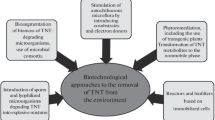Abstract
The explosive 2,4,6-trinitrotoluene (TNT), one of the most abundant and persistent contaminants at former armament factories and military sites, was cometabolically reduced by sludge (mixed culture) from a sewage plant in order to facilitate mineralization in a subsequent photochemical treatment. Under aerobic conditions, the main reduction products were aminodinitrotoluenes (ADNTs). A greater amount of the nitroaromatics (ca. 30%) was adsorbed by the sludge as was shown by a complete balance of the process using 14C-TNT. Under anaerobic conditions, TNT was further converted into ADNTs and diaminonitrotoluenes (DANTs) while only negligible adsorption to the sludge occured.
Similar content being viewed by others
References
Achtnich C, Lenke H, Klaus U, Spiteller M & Knackmuss H-J (2000) Stability of immobilized TNT derivatives in soil as a function of nitro group reduction. Environ. Sci. Technol. 34: 3698-3704
Carpenter DF, McCormick NG, Cornell JH & Kaplan AM (1978) Microbial transformation of 14C-labelled TNT in an activated-sludge system. Appl. Environ. Microbiol. 35: 949- 954
Corbett MD & Corbett BR (1995) Bioorganic chemistry of the arylhydroxylamine and nitrosoarene functional groups. In: Spain JC (Ed) Biodegradation of Nitroaromatic Compounds. Plenum Press, New York
Drzyzga O, Bruns-Nagel D, Gorontzy T, Blotevogel K & von Löw E (1999) Anaerobic incorporation of the radiolabelled explosive TNT and metabolites into the organic soil matrix of contaminated soil after different treatment procedures. Chemosphere 38: 2081-2095
Eilers A, Rüngeling E, Stündl UM & Gottschalk G (1999) Metabolism of TNT by the white-rot fungus bjerkanda daustadsm 3375 depends on cytochrome P-450. Appl. Microbiol. Biotechnol. 53: 75-80
Haas R & von Löw E (1986) —Grundwasserbelastung durch eine Altlast. Die folgen einer ehemaligen Sprengstoffproduktion für die heutige Trinkwassergewinnung. Forum Städte-Hygiene 37: 33-43
Hawari J, Beaudet S, Halasz A, Thiboutot S & Ampleman G (2000) Microbial degradation of explosives: biotransformation versus mineralization. Appl. Microbiol. Biotechnol. 54: 605-618
Hess TF, Lewis TA, Crawford RL, Katamneni S, Wells JH & Watts RJ (1998) Combined photocatalytic and fungal treatment for the destruction of 2,4,6-trinitrotoluene. Water Res. 32: 1481-1491
Hwang H-M, Slaughter LF, Cook SM & Cui H (2000) Degradation of TNT in a freshwater environment. Bull. Environ. Contam. Toxicol. 65: 228-235
Knackmuss H-J, Daun G, Lenke H & Reuss M (1998) Biological treatment of TNT-contaminated soil 1. Anaerobic cometabolic reduction and interaction of TNT and metabolites with soil components. Environ. Sci. Technol. 32: 1956- 1963
Kröger M & Fels G (2000) 14C-TNT synthesis revisited. J. Labelled Cpd. Radiopharm. 43: 217-227
Kröger M & Fels G (2002) Microbiotic synthesis of 14Cringlabelled aminodinitrotoluenes (ADNT) and diaminonitrotoluenes (DANT). J. Labelled Cpd. Radiopharm. 45: 249- 255
Lewis TA, Ederer MM, Crawford RL & Crawford DL (1997) Microbial transformation of 2,4,6-trinitrotoluene. J. Industr. Microbiol. Biotechnol. 18: 89-96
Riefler RG & Smets BF (2000) Enzymatic reduction of TNT and related nitroarenes: kinetics linked to one-electron redox potentials. Environ. Sci. Technol. 34: 3900-3906
Scheibner K, Hofrichter M, Herre A & Michels J (1997) Screening for fungi intensively mineralizing TNT. Appl. Microbiol. Biotechnol. 47: 452-457
Schlesselmann E (1996) Diploma Thesis, University of Braunschweig, Braunschweig
Sitzmann M (1974) Chemical reduction of TNT - initial products. J. Chem. Eng. Data 19: 179-181
Spain JC (1995) Biodegradation of nitroaromatic compounds. Annu. Rev. Microbiol. 49: 523-555
Spain JC & Hughes J (2000) Biodegradation of Nitroaromatic Compounds and Explosives. CRC Press, Boca Raton
Wild JR, Kalafut T, Wales ME, Rastogi VK, Naumova RP & Zaripova SK (1998) Biotransformation patterns of 2,4,6-TNT by aerobic bacteria. Curr. Microbiol. 36: 45- 54
Yinon J (1990) Toxicity and Metabolism of Explosives. CRC Press, Boca Raton
Author information
Authors and Affiliations
Rights and permissions
About this article
Cite this article
Kröger, M., Schumacher, M.E., Risse, H. et al. Biological Reduction of TNT as Part of a Combined Biological–Chemical Procedure for Mineralization. Biodegradation 15, 241–248 (2004). https://doi.org/10.1023/B:BIOD.0000042914.53688.63
Issue Date:
DOI: https://doi.org/10.1023/B:BIOD.0000042914.53688.63




